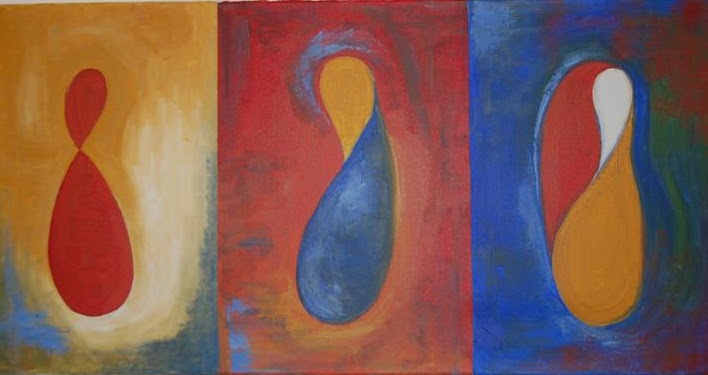Mathematics as a Muse - Mrs Vaze Staff Spotlight
- Rachell Lee

- Oct 14
- 4 min read

Anyone who’s walked up to the fourth floor math corridor will recognize the colorful paintings that adorn those walls. But have you ever taken a closer look? The first time I did, I froze in my tracks. The paintings were by Mrs Vaze, my own math teacher! It was like discovering her secret double life, yet it made perfect sense - Mrs Vaze is the type of teacher who loves adding mathematical story interludes to our classes, whether it’s about how the Pythagoras theorem was NOT discovered by Pythagoras, or how René Descartes invented the Cartesian coordinate plane after observing a buzzing fly. After all, paintings are a form of storytelling too.
Her painting story started 17 years ago, at a math and art jam. Each person was given a blank canvas to paint and afterwards, Mrs Vaze said she had “so much fun thinking about what to paint and how to paint” that a new passion was born there. Her first painting, inspired by the different nets of a cube, led to a foray into representing shapes on canvas, from ‘The Persistence of Shape’, a tangram like investigation into rearranging shapes, to the ‘Three Sisters’, inspired by the Four Color Theorem.
Soon after, mathematicians started popping up in her work - Klein, Gauss, Fermat, Lucas, Fibonacci - they all walked the earth again through Mrs Vaze’s canvas. Of these, I like the Lucas painting the most. Taking inspiration from the mathematical puzzle Lucas invented, The Tower of Hanoi, Mrs Vaze used the letters of his name to recreate the steps in the puzzle within the painting.

Later on, she started playing with representing numbers visually, which included a series of paintings inspired by magic squares. These paintings depict numbers in unique ways, such as through the intersections of lines or the areas of rectangles to form a visual magic square.
I find the idea of depicting numbers - these cold, black symbols with harsh edges - as such dynamic and colorful compositions quite intriguing. It really makes you wonder, what else is possible at the intersection of fields?
Well, we’re about to find out! Take a look at this series of paintings - which one do you think is the odd one out?
That’s right, it’s number 4! In all four paintings, the area of the rectangles come from a sequence found from taking the digital root of a number sequence. The first one comes from triangle numbers, the second from the Fibonacci sequence, and the third one from the pentagonal numbers. What’s most curious is that these digital root sequences repeat! That’s why the first three paintings have a neat, spiraling shape.
Fun Fact: How to take the digital roots of a sequence
Digital roots must be numbers between 1-9. To find the digital roots of a sequence, keep adding up the digits in a number until it makes a single digit.
For example:
Initial sequence: 1, 20, 53, 61, 98
The digital roots of this sequence is: 1, 2, 8, 7, 8 because
1 = 1
2+0 = 2
5+3 = 8
6+1 = 7
9+8 = 17 AND THEN 1+7 = 8
For the Fibonacci sequence, the digital roots are 1, 1, 2, 3, 5, 8, 4, 3, 7, 1, 8, 9, 8, 8, 7, 6, 4, 1, 5, 6, 2, 8, 1, 9 and after that, it keeps repeating from 1 again.
This discovery was very exciting, and filled with curiosity, Mrs Vaze painted more sequences, seeing if they would all fit the pattern. But when she tried to find the digital roots of partitions of numbers, things fell apart. The sequence wouldn’t repeat! No matter how many digits she found, the numbers just kept wirthing left and right, refusing to settle into a neat, repeating sequence.
Eventually, Mrs Vaze realized what she had found - a completely new sequence of numbers! In fact, this sequence has been officially recorded in the Online Encyclopedia of Integer Sequences, and can be found there by searching its unique serial code ‘A238191’.
This discovery beautifully demonstrates how for Mrs Vaze, art and math are intrinsically intertwined. While her paintings start with a mathematical concept, it’s through painting that she makes new discoveries about the math involved. This cycle really goes to show that even though math and art might seem like opposite ends of the spectrum, in reality, they’re really just different accents of the same universal language.
Another aspect I love about her paintings is how she uses things we might take for granted - like the dimensions of a canvas - and incorporates it into her art, creating a playful experimentation with the very medium of painting. For example, when she tried representing sequences of shapes, her canvas expanded far beyond anything that could be held on an easel! Stitched on a sari, this painting shows all the possible arrangements of 7 non-intersecting circles. Another painting in this series, using 5 circles instead and titled ‘Lily Pads’, can be found in the math corridor.
Representing mathematical concepts in creative ways - that is the crux of Mrs Vaze’s art. These days, Mrs Vaze is still painting regularly, and in fact, she says that “after teaching, I go home and think about what to paint.” After all, when you have mathematics as your muse, how could you possibly run out of angles to paint her from?



























Comments